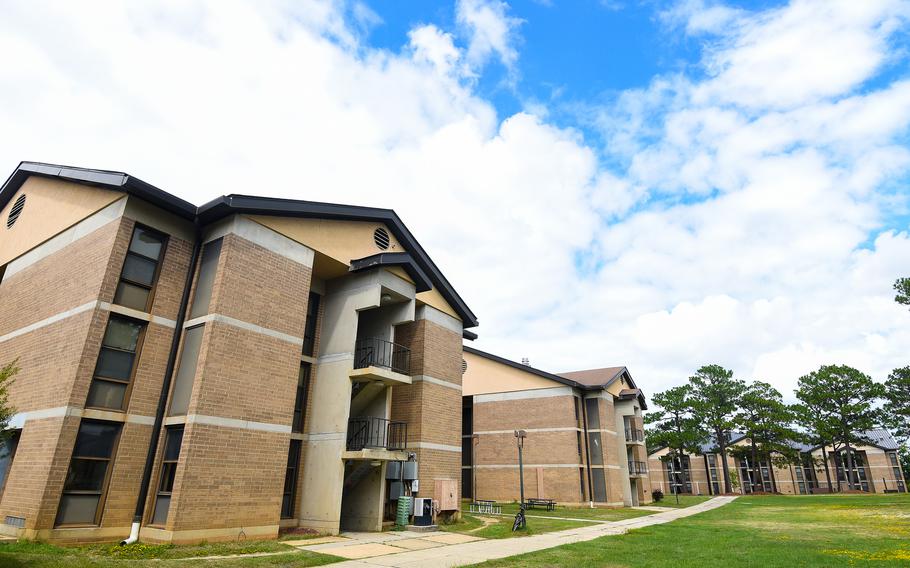
The Army will spend some $145 million tearing down 12 barracks buildings and refurbishing five others in the Smoke Bomb Hill area of Fort Bragg, N.C., seen in this photo taken Sept. 8, 2022. (Corey Dickstein/Stars and Stripes)
More soldiers might soon be permitted to move out of barracks as the Army explores expanding what ranks can live off base to combat overcrowded and unsafe conditions after years of budget tightening has caused living quarters to deteriorate, according to a senior service official.
“In the face of funding challenges, the Army must examine a number of barracks-related issues to make sure investments are prioritized for optimal effect,” said Rachel Jacobson, assistant secretary of the Army for Installations, Energy and Environment. “This includes analyzing barracks inventory, the physical condition of barracks and supporting infrastructure, and assignment policies for unaccompanied housing.”
Single soldiers at bases in the United States must live in barracks until they are married or attain the rank of staff sergeant. At that time, they can collect a housing allowance and move off the installation. The Marine Corps has a similar policy, while the Air Force and Navy allow troops to move out on their own at a lower rank, according to Military OneSource, a Defense Department information hub for families.
The review is still in its early stages with no timeline of when any of its ideas and research could become service policy.
Army Secretary Christine Wormuth said this month that the service has not invested enough in housing and needs to improve soldiers’ quality of life.
Fort Bragg in North Carolina and Fort Hood in Texas are two of the Army’s largest bases in terms of population and where barracks problems have been reported.
At Fort Bragg, leaders in August ordered nearly 1,200 soldiers to move immediately because of unsafe living conditions in more than a dozen barracks buildings.
About 75% of those affected soldiers had moved by Friday as officials continued to track down available living quarters for the others. More than 400 troops were either approved to move off base or were waiting for approval.
The Army spends about $1 billion each year on its barracks projects across the active-duty and Reserve components using military construction funding and restoration and modernization money, according to a senior Army official who spoke on condition of anonymity. While it’s important to prioritize how all that money is spent, the official said the Army should also review policies “to ensure that we're not housing soldiers who we don't need to be.”
“We need to think a little bit more than just about brick and mortar to solve our problems. When you combine what we're doing with military construction, and the restoration and modernization piece with maybe doing some other things that are innovative or thoughtful, then that helps you get at the overall requirement,” the official said. “There's no single solution for this.”
The Fort Bragg evacuation forced the Army to shift $115 million in the service’s budget to pay for demolishing or renovating and refurbishing the more than 40-year-old barracks buildings at the North Carolina base where the problems persisted. But the budget shift did not cause any other projects to lose funding, according to a second Army official speaking on condition of anonymity.
“Every year we'll identify some contingency funding in order to get after our emergencies,” the official said. They can also redirect savings from projects that come in under budget or projects that don’t move forward for some reason.
At Fort Hood in Texas, they are almost 4,000 beds short of what’s needed for the force, according to Brian Dosa, director of the Fort Hood Directorate of Public Works. Limited barracks space forces soldiers to share rooms meant for one person and they don’t have the space and privacy outlined in Army regulation.
“Some of that is we never had enough barracks to start with,” Dosa said last year. “As we renovate barracks to the Army standard, we're giving soldiers the space that they're supposed to have, so we're coming out with less barracks rooms or beds at the end of the renovation.”
Building enough barracks for all the soldiers on base is a “huge priority,” he said, but construction money is tougher to get than renovation funding.
Jacobson said the Army teams tasked with reviewing barracks issues will look at the active and reserve components as part of their work.
“Army leadership, including senior enlisted leaders and representatives from across Army commands, is focused on establishing strong policies and practices to provide quality housing to single soldiers across the Total Army,” she said.